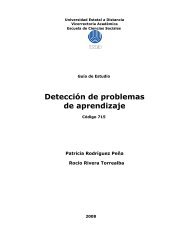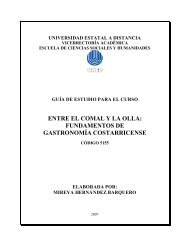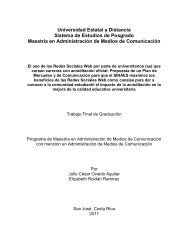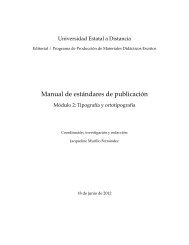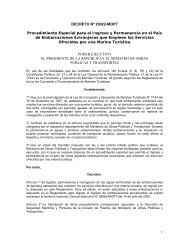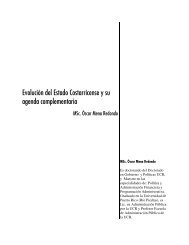GE3011 Cálculo Superior - Repositorio de la Universidad Estatal a ...
GE3011 Cálculo Superior - Repositorio de la Universidad Estatal a ...
GE3011 Cálculo Superior - Repositorio de la Universidad Estatal a ...
You also want an ePaper? Increase the reach of your titles
YUMPU automatically turns print PDFs into web optimized ePapers that Google loves.
GUÍA DE ESTUDIO: CÁLCULO SUPERIOR 31<br />
2. Usando el principio <strong>de</strong> Cavalieri, calcu<strong>la</strong>r el volumen <strong>de</strong> <strong>la</strong> estructura mostrada en <strong>la</strong> figura<br />
5.1.11, página 317; cada sección transversal es un rectángulo <strong>de</strong> longitud 5 y ancho 3.<br />
Solución: Para calcu<strong>la</strong>r el volumen <strong>de</strong> <strong>la</strong> estructura, observe que cada sección transversal es<br />
un rectángulo <strong>de</strong> 5 <strong>de</strong> <strong>la</strong>rgo por 3 <strong>de</strong> ancho, <strong>de</strong> modo que A(x) = 15 (el área <strong>de</strong>l rectángulo<br />
que correspon<strong>de</strong> a <strong>la</strong> sección transversal). Si se toma como p<strong>la</strong>no <strong>de</strong> referencia <strong>la</strong> base <strong>de</strong> <strong>la</strong><br />
estructura entonces <strong>la</strong> distancia mínima es 0 (<strong>la</strong> base está sobre el p<strong>la</strong>no) y <strong>la</strong> máxima es 7<br />
(<strong>la</strong> altura <strong>de</strong> <strong>la</strong> estructura), <strong>de</strong> modo que el volumen <strong>de</strong> <strong>la</strong> estructura es (según el principio<br />
<strong>de</strong> Cavalieri): V =<br />
7<br />
<br />
3. Evaluar <strong>la</strong> integral doble<br />
Solución:<br />
0<br />
(15)dx = 15x | 7<br />
0<br />
R<br />
= 105 − 0 = 105.<br />
<br />
|y| cos 1<br />
4 πx<br />
<br />
dydx, don<strong>de</strong> R = [0, 2] × [−1, 0].<br />
En <strong>la</strong> región propuesta se tiene que y ≤ 0, por lo tanto |y| = −y; entonces<br />
<br />
|y| cos<br />
R<br />
1<br />
4 πx<br />
2 0 <br />
dydx = −y cos<br />
0 −1<br />
1<br />
4 πx<br />
<br />
dydx<br />
2 <br />
= −<br />
0<br />
1<br />
2 y2 cos π<br />
4 x<br />
0 dx<br />
−1<br />
2 <br />
1 π<br />
= cos<br />
0 2 4 x<br />
<br />
dx<br />
= 2 π<br />
sen<br />
π 4 x<br />
2<br />
<br />
<br />
= 2<br />
<br />
sen<br />
π<br />
π<br />
<br />
− sen 0 =<br />
2 2<br />
π .<br />
4. Evaluar <strong>la</strong> integral <br />
R<br />
sen(x + y) dx dy, don<strong>de</strong> R = [0, 1] × [0, 1].<br />
Solución: De acuerdo con el teorema <strong>de</strong> Fubini:<br />
<br />
sen(x + y) dxdy<br />
R<br />
=<br />
=<br />
=<br />
1 1<br />
0<br />
1<br />
0<br />
1<br />
0<br />
0<br />
0<br />
sen(x + y) dxdy<br />
[− cos(x + y)] 1<br />
0 dy<br />
(− cos(1 + y) + cos(y)) dy<br />
= [− sen(1 + y) + sen(y)] 1<br />
0<br />
= − sen 2 + sen 1 + sen 1 − sen 0<br />
= − sen 2 + 2 sen 1.<br />
UNED Acortando distancias



